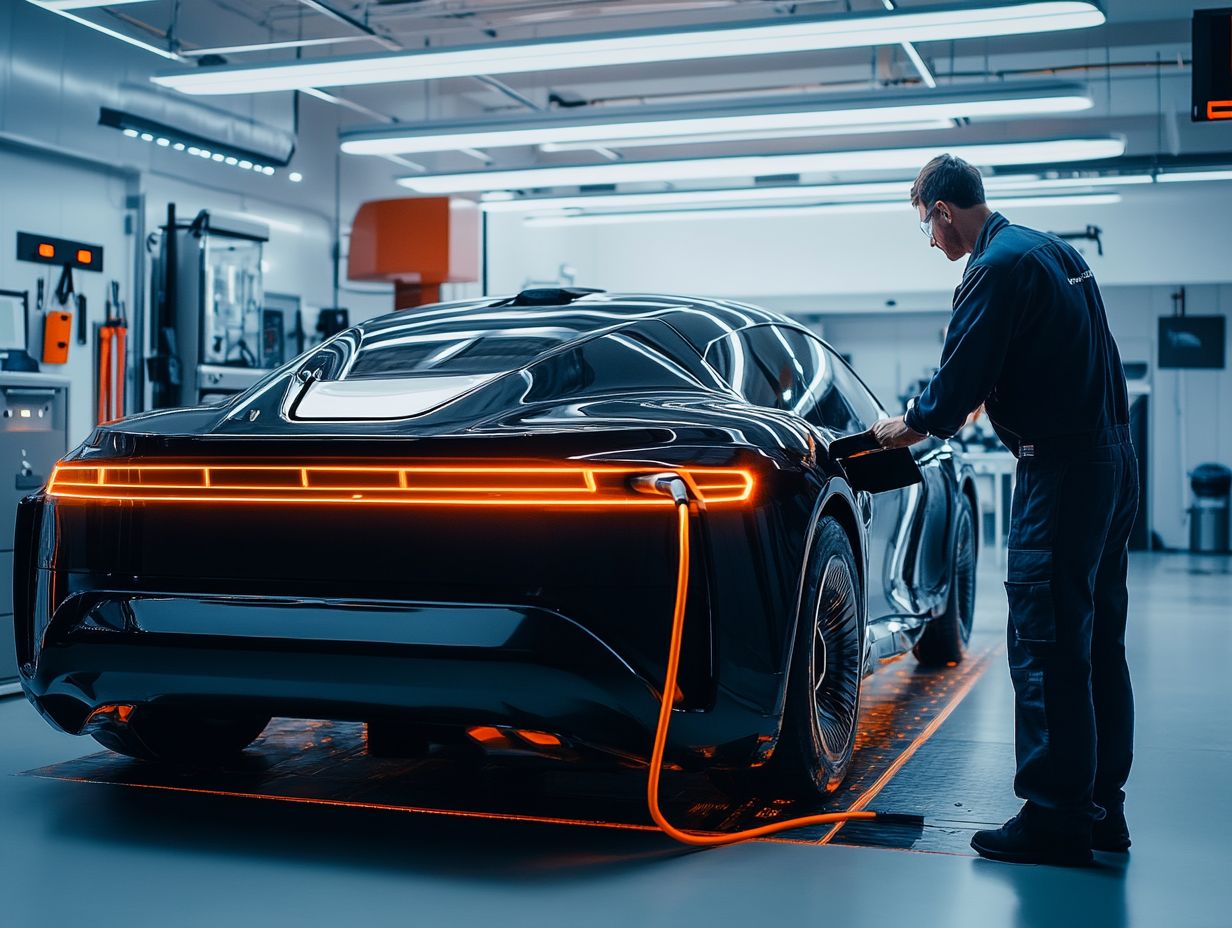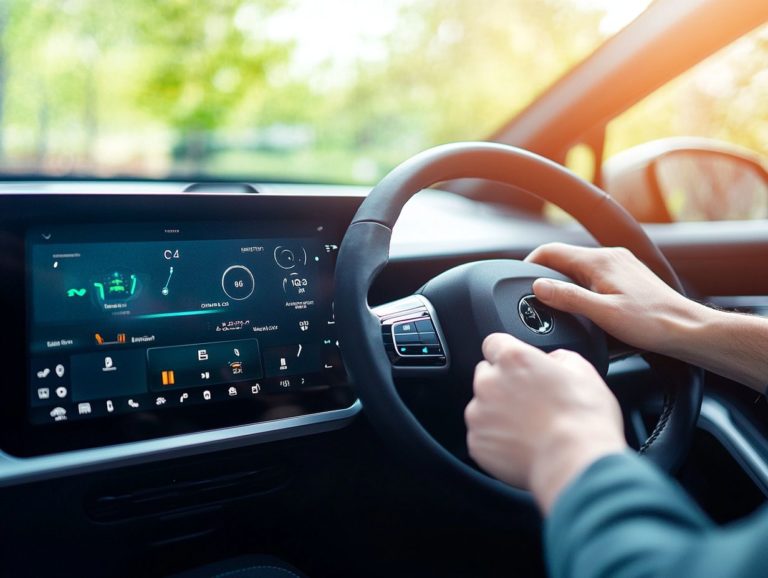Best Practices for EV Body Maintenance
As electric vehicles (EVs) gain traction, understanding body maintenance is essential for longevity and performance. Engaging in proper EV body maintenance elevates your vehicle’s aesthetic appeal while safeguarding safety and efficiency.
This article delves into the significance of regular upkeep, outlines common maintenance tasks, and offers a comprehensive step-by-step guide to ensure your EV remains in pristine condition. From tire rotations to battery care, you ll uncover the best practices that will keep your vehicle looking fabulous and running smoothly.
Contents
Key Takeaways:

- Keep your EV running longer with regular body maintenance.
- Perform routine tasks like tire rotation and brake inspection to prevent costly repairs and improve performance.
- Maintain cleanliness and protection of the exterior and interior to keep your EV looking new for years.
What is EV Body Maintenance?
EV body maintenance encompasses a thorough set of procedures essential for preserving the integrity and performance of electric vehicles (EVs) like the Chevrolet Bolt EV and Nissan Leaf. This process includes routine inspections, repairs, and specialized care designed to tackle the unique challenges posed by the powerful battery systems and complex electrical components used in EVs.
Understanding this maintenance is crucial for you as an EV owner. Unlike conventional cars, electric vehicles depend heavily on intricate battery systems, making battery care your top priority for optimal performance and longevity.
Paying attention to proper tire pressure is equally crucial, as it directly affects energy efficiency and handling two factors that vary significantly from the driving dynamics of gasoline cars. Following factory recommendations for fluid maintenance ensures that your vehicle’s systems operate smoothly, helping you avoid costly repairs down the line.
By embracing these tailored practices, you enhance your ownership experience and elevate performance standards specific to electric vehicles.
Why is EV Body Maintenance Important?
Understanding the significance of EV body maintenance is essential for you as an electric vehicle owner. It directly impacts your maintenance and repair costs, as well as the overall longevity of your vehicle. For effective care, refer to the top tips for electric vehicle cleaning.
Attentive upkeep ensures you comply with warranty terms and safety regulations, safeguarding both your investment and your peace of mind.
Benefits of Regular Maintenance
Regular maintenance of electric vehicles presents numerous advantages:
- Extends battery life.
- Reduces repair costs.
- Ensures compliance with warranties.
- Enhances safety through the use of appropriate safety equipment.
By prioritizing these routine checks, you can significantly boost battery maintenance, which is essential for achieving optimal performance and longevity. A well-maintained battery operates efficiently and minimizes environmental impact, fostering sustainability by reducing the need for premature replacements and cutting down on waste.
Timely interventions keep repair costs in check, as addressing minor issues prevents them from escalating into major, expensive repairs. Sticking to maintenance schedules also ensures warranty compliance, protecting your investment and instilling confidence in your vehicle’s reliability.
Incorporating proper safety measures during maintenance enhances overall safety, providing you with peace of mind while bolstering your vehicle’s operational security.
Common Maintenance Tasks for EV Bodies
Common maintenance tasks for electric vehicle bodies require a thorough series of mechanical inspections and regular check-ups. This includes attentive battery maintenance, diligent tire pressure monitoring, careful fluid upkeep, and DIY maintenance tips for electric vehicles, all essential for ensuring optimal performance and safety.
Tire Rotation and Inspection

Tire rotation and inspection are essential maintenance tasks for electric vehicles. They ensure even weight distribution and optimal tire pressure while enhancing safety and extending tire life.
To effectively carry out tire rotation, follow specific steps that contribute to your vehicle’s longevity. Start by gathering the necessary tools: a jack, jack stands, and a lug wrench. Aim to rotate your tires every 5,000 to 7,500 miles, as recommended by manufacturers to promote even tread wear and improve handling.
Maintaining proper tire pressure is crucial, typically around 32 to 35 PSI for most electric vehicles. Underinflated or overinflated tires can decrease efficiency and accelerate wear. Regular inspections play a vital role in spotting damage or irregularities that could impact performance, ensuring a safer and more enjoyable driving experience.
Brake Inspection and Replacement
Regular brake inspection and replacement are essential for your safety in electric vehicles. This addresses wear and tear in the brake system and prevents costly repairs down the line.
The brake systems in electric vehicles operate quite differently from those in traditional gasoline-powered cars. This is largely due to their regenerative braking features (a system that recovers energy during braking). This technology enhances efficiency and requires technicians to have a deep understanding of its unique intricacies.
As the market shifts toward electric mobility, there s a growing demand for specialized training focused on the latest industry safety standards and regulatory requirements. This empowers technicians to tackle unique challenges with confidence!
Grasping these differences is crucial for maintaining the overall reliability and performance of electric vehicles while adhering to necessary safety protocols.
Battery Maintenance
Battery maintenance is essential for anyone who owns an electric vehicle. It directly influences the longevity of the battery pack, overall battery life, and performance efficiency during operation.
To ensure your vehicle runs at its best, regularly perform specific tasks, including monitoring coolant levels, which helps prevent overheating. Regular fluid checks are equally important; they help spot any leaks or degradation that could affect the system s performance.
By keeping a vigilant eye on these critical elements, you can mitigate potential issues and extend both the lifespan and reliability of your battery. Embracing these maintenance practices sets the stage for your electric vehicle to operate efficiently, enhancing your driving experience and promoting sustainability.
How to Perform EV Body Maintenance
Conducting EV body maintenance requires a carefully planned schedule. This must include regular mechanical inspections, the use of specialized training, and the adoption of advanced diagnostic tools to keep your vehicle safe and efficient. Additionally, it’s essential to follow best practices for EV battery care to ensure optimal performance.
Step-by-Step Guide
This step-by-step guide on EV body maintenance offers essential instructions for conducting routine maintenance checks, fluid checks, and battery upkeep. Additionally, you can learn how to maintain your EV’s exterior finish, ensuring your vehicle stays in optimal condition.
Understanding the nuances of each process is vital for longevity and safety, especially if you depend on electric vehicles for your daily commute. Proper maintenance requires specific tools, such as torque wrenches, fluid testers, and specialized battery management systems, enabling you to diagnose and repair issues efficiently.
By following each outlined protocol, you ll identify potential hazards, safeguarding both yourself and your vehicle. Specialized training is crucial for handling high-voltage systems. This equips you with the knowledge to manage intricate electrical components safely, ultimately enhancing the reliability of your EV.
Recommended Maintenance Schedule

A carefully created maintenance schedule is essential for you as an electric vehicle owner. This schedule outlines the frequency of essential maintenance tasks, ensuring you adhere to factory recommendations and achieve optimal vehicle performance.
Frequency of Maintenance Tasks
The frequency of maintenance tasks for your electric vehicle varies based on several factors. These include the vehicle model, your driving habits, and specific manufacturer recommendations. This ensures you enjoy consistent performance and safety.
Check your battery every six months. Look for corrosion and ensure connections are secure. You should also perform fluid checks quarterly to ensure that your coolant a fluid that helps keep your vehicle’s battery at the right temperature and brake fluid levels are adequate. These checks are crucial for cooling the battery and ensuring effective braking.
It’s also recommended to conduct thorough vehicle inspections at least once a year. This will help identify any wear and tear that could impact performance. This proactive maintenance approach not only extends the longevity of your vehicle but also significantly enhances your overall driving experience.
Tips for Maintaining EV Body Appearance
Maintaining the appearance of electric vehicles goes beyond mere aesthetics; it’s all about keeping your vehicle clean and safe. For more insights, check out what are the maintenance needs of EVs? This not only enhances the vehicle’s overall value but also helps reduce its environmental footprint.
Taking these steps ensures your electric vehicle remains a shining example of both beauty and sustainability, particularly when you consider understanding EV regulations and maintenance!
Cleaning and Protecting the Exterior
Cleaning and protecting the exterior of your electric vehicle is essential for maintaining its pristine appearance and preventing potential damage. Utilizing essential resources for EV maintenance while embracing eco-friendly practices will help reduce your environmental footprint.
To achieve the best results, adopt a gentle approach when washing. Choose biodegradable soaps that are safe for both your car’s surface and the environment. This ensures you don t introduce harsh chemicals that could harm the vehicle s paint. Using microfiber cloths or sponges will help minimize scratches, and a thorough rinse will effectively remove dirt and grime.
After washing, follow up with waxing! This not only enhances your vehicle s shine but also protects it from damage by creating a protective barrier against UV rays and contaminants.
As an eco-conscious owner, consider exploring protective sealants, which are products that protect your vehicle s surface. These can provide additional defense against the elements, ultimately prolonging the life of your vehicle’s exterior.
Caring for the Interior
Caring for the interior of your electric vehicle requires a blend of regular cleaning and maintenance practices that ensure your comfort while considering the environmental impact of your choices.
To keep your interior in pristine condition, incorporate strategic vacuuming to eliminate dirt and debris from those hard-to-reach nooks and crannies. For tackling stains, employing effective removal techniques can significantly enhance the aesthetic appeal of the cabin. This allows you to address spills promptly and efficiently.
Opting for eco-friendly cleaning supplies is a savvy move! They promote a healthier environment while also safeguarding your vehicle’s materials, making them an excellent choice for sustainability-conscious drivers.
By regularly attending to these maintenance practices, you not only prolong the life of your interior but also ensure a delightful driving experience, all while contributing to a greener planet.
Frequently Asked Questions

What are the best practices for maintaining the body of an electric vehicle?
Regularly washing and waxing the exterior, avoiding harsh chemicals, and inspecting for any signs of damage are all important steps in maintaining your electric vehicle. For more tips, check out the best practices for maintaining your EV.
How often should I wash my electric vehicle’s body?
Wash your electric vehicle at least once a month, or more if conditions are tough.
Washing Your Electric Vehicle? Here s What to Know!
Avoid rough cleaning materials and harsh chemicals. These can damage your vehicle’s paint and protective coating.
Use mild soap and a soft cloth instead.
Should You Wax Your Electric Vehicle?
Waxing protects your paint and makes your vehicle look great. Aim to wax your electric vehicle every 3-6 months.
Spot Damage? Here s What to Do!
Notice scratches or dents? Act quickly! This helps prevent further damage and keeps your vehicle s value high.
Need More Maintenance Tips for Your Electric Vehicle?
Inspect your vehicle regularly for wear like rust or chipping paint. Store it in a covered area to shield it from the elements.






